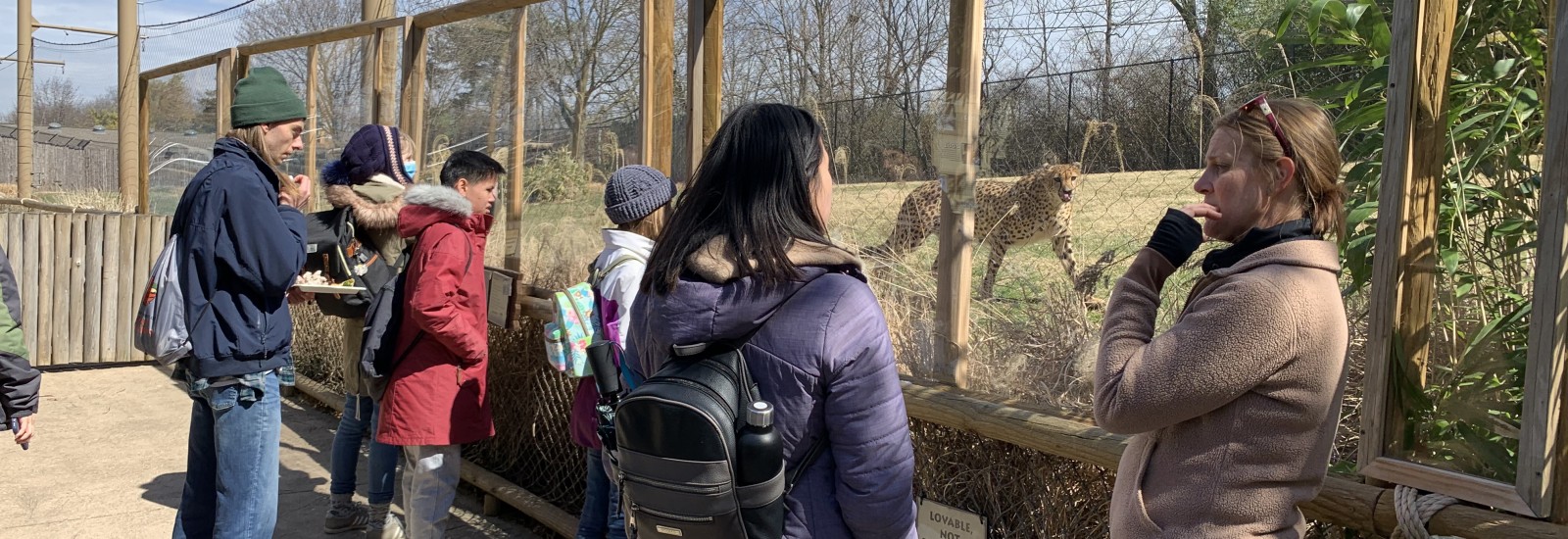Sustainability initiatives stole the show from the animals when students from Ohio State’s SUSTAINS Learning Community visited the Cincinnati Zoo & Botanical Garden in March.
“It was so cool to see their aerobic organic waste digester that helps reduce the amount of food they throw in the landfill and their large water management system that allows them to take no water from the grid and manage the stormwater that falls onto their campus,” Cade Capper, a senior majoring in environmental science, says of the zoo. “They brought sustainability to their operations all while keeping the well-being of their animals at the forefront of their minds. I also really liked learning about the city’s sustainability initiatives and plans because they were very thorough and considered every aspect of sustainability while setting goals with actionable steps that truly make a difference in their environmental impact.”
The trip by the Students Understanding Sustainability and Taking Action to Improve Nature and Society (SUSTAINS) Learning Community, included stops to see sustainability in action at an array of businesses and nonprofit organizations. In SUSTAINS, students of any major live alongside their peers and explore and engage with sustainability topics and learn how sustainable actions impact society. Ohio State’s Sustainability Institute and University Housing provide programming for SUSTAINS.
“By partnering with Ohio State to create these experiential learning opportunities, companies and non-profits enable our students to see sustainability in real world settings,” says Matt Griffin, the program coordinator of sustainability education and learning for Ohio State’s Sustainability Institute and academic lead for SUSTAINS. “Students gain a better understanding of the sustainability challenges these organizations are facing today, and the companies connect with passionate students who provide insight into what recent graduates are looking for from their future places of employment.”
Abby Thiel, a junior studying environment, economy, development and sustainability with a specialization in community development, says the diversity of groups and businesses the students visited gave her direct insight about the many ways people can approach sustainability.
“I was able to compare experiences from both small- and large-scale business and nonprofit and government perspectives, and this gave me a better understanding about the unique sustainability opportunities and challenges faced by different types of organizations,” she says. “Through asking questions, I also gained a deeper understanding about the interplay between these different organizations, which gave me a more comprehensive understanding of how sustainability is addressed on a much broader community scale.”
Griffin says support from the Marathon Petroleum Foundation allowed SUSTAINS students to extend their time in Cincinnati to connect with more businesses and non-profits working in sustainability. Marathon made a $250,000 donation to benefit undergraduate and graduate students in Ohio State’s School of Environment and Natural Resources and to advance terrestrial wildlife ecology research, student learning and sustainability, and diversity and inclusion scholarships. “The company’s support will also allow for our students to visit a right-of-way where Marathon is partnering with Ohio State faculty to develop more sustainable and equitable land-use techniques,” Griffin adds.
Also during the Cincinnati trip, the SUSTAINS students visited Electrada, a start-up that is working to expand electric car infrastructure across the country.
“Electrada had a diverse team from a wide number of disciplines, all united by their passion for sustainable infrastructure,” says Griffin. “It was great for our students to see that people from all backgrounds and identities can work to create sustainable solutions. Electrada noted the importance of showing students the potential that start-ups have to create a more sustainable world, and how a small group of passionate individuals can make a big impact.”
Thiel, who is also pursuing a double minor in geographic information science and in city and regional planning, wants to contribute to work relating to sustainable urban development after she graduates.
“One of my favorite parts of the trip was visiting 80 Acre Farms, which is a large-scale indoor hydroponic farming facility. I grew up in an agriculture focused community, so having the opportunity to learn about a completely different farming practice was particularly impactful and inspiring,” Thiel says. “It was fascinating to see what accomplishments are already being achieved through this work, and it's exciting to imagine how this technology could evolve in the future.”
Capper, who plans to seek a profession in wildlife ecology, conservation and research, says the trip offered him networking opportunities and the chance to see sustainability in action in such a wide variety of areas.
“It helped me look at my own career goals and compare them in reference to the other opportunities out there,” says Capper, “and make sure that the career that I’m shooting for aligns well with my interests and that I’m setting myself up for success in my chosen field.”
By Joan Slattery Wall, editor, Sustainability Institute at Ohio State
Learn more about the SUSTAINS Learning Community.
